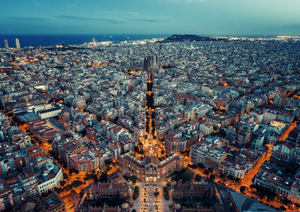As the second largest city in Spain, Barcelona is a seaside city on the Mediterranean coast that welcomes over 9 million tourists each year and is home to almost 6 million inhabitants.
Traditional food...
Just like any Spanish city, Barcelona has its own, distinct cuisine unlike any other that has developed over centuries. One of the most iconic tapas dishes is ‘La Bomba’, named after the grenades thrown towards the dictator Franco’s fascist army in defence during the Spanish Civil War. They became an inspiration to a local chef who created a tennis ball-sized potato croquette that is served with a garlic allioli sauce and a spicy red sauce.
Another authentic piece of Barcelona cuisine is a salad made from cod (‘bacalao’) and served with a romescu sauce (a traditional Catalan salsa made with hazelnuts, almonds, and red peppers), tomatoes, onions and olives. This is known as ‘esqueixada’, pronounced ‘ess-keh-sha-da’.
Fiestas...
Although the region of Cataluña has many fiestas that are celebrated throughout the year; it would be fair to say that their most important fiesta is ‘El Día de Sant Jordi’ which is celebrated on the 23rd of April. This is like a blend of what we celebrate as World Book Day and St Valentine’s Day. It is custom for couple to exchange gifts, with the men buying roses for women, and women giving books to men. The tradition stems from the legend of Saint George, a knight who slayed a dragon and went on to give a rose that came from the beast’s body to a princess.
Another fiesta that is celebrated in on the beaches up the coast of Catalonia is known as ‘The Eve of Sant Joan’ and is considered to be the biggest party night of the year, consisting of fireworks and bonfires into the early hours. This happens on 23rd June, as the 24th June is a bank holiday and, just like any bank holiday, lots of food and drink is consumed. Streets parties are organised with a variety of musicians and DJs, predominantly in the Old Town District and Barceloneta (the beach).
Barcelona’s must sees-
The most famous landmark in Barcelona would have to be ‘La Sagrada Familia’; a huge basilica designed by the famous Antonio Gaudí, which has even been under construction since 1882- it’s not due to be finished for at least another 50 years! It is listed on UNESCO, and dominates the Barcelona skyline, with the ability to see the 18 huge towers from miles away.

Antonio Gaudí had a huge influence on the architecture that is featured throughout Barcelona. He built various houses in the city, all with their own unique construction. ‘Casa Mila’, also known as ‘La Pedrera’, is characterised by wavy brick work and is located on one of the busiest streets in the city. Over the road, ‘Casa Batlló’ is located and is a modernist building with freely swinging shapes and ornamental façade. And, of course, the most famous of Gaudí’s work would have to be the surrealist park, built on the mountain side, offering panoramic views of the city and being able to see as far out as the sea. Created in the early 1900s, the ‘Parc Güell’ show cases Gaudí’s architectural style with winding staircases, multi-coloured ceramic fragments and even being where his home was located. Now turned into a museum, Gaudí’s home was simplistic and displays a collection of art and furniture, designed by himself.
‘La Rambla’ is described as being the social hub of Barcelona, stretching from the ‘Plaça Catalunya’ (the main square in Barcelona) all the way down to the port, where you will find ‘La Barceloneta’ (the seaside neighbourhood of Barcelona). This pedestrianised street ‘La Rambla’ is lined with shops, restaurants, cafes and market stalls.

Language and Dialect...
Barcelona is the capital of the region of Catalonia (Cataluña) which is the home of the largest co-official language, Catalan, boasting over 7 million speakers, and a further 5 million who speak it as a second language. Due to its geographical location and its Latin roots, it has lots of similarities with French, Spanish, Portuguese and Italian, which all belong to the family of Romance languages. There are also variations of Catalan that is spoken in the Balearic Islands and Valencia. Just like any language, Catalan has various accents across the region, and many people are brought up bilingual- being taught both ‘Castellano’ and Catalan.

